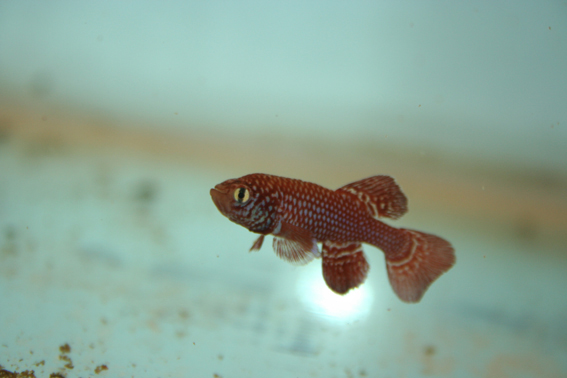|
Dorsal spines (total): 0-0; Dorsal soft rays (total): 13-14; Anal spines: 0-0; Anal soft rays: 13-16. Diagnosis: Nothobranchius kadleci is distinguished from N. furzeri by the smaller depth of the dorsal fin, 17.9-31.0% of standard length vs. 27.4-37.7% in males, 14.9-17.6% of standard length vs. 19.0-21.9% in females; smaller depth of the anal fin, 17.4-25.8% of standard length vs. 22.4-32.4% in males, 17.3-19.2% of standard length vs.19.3-24.5% in females; larger preanal distance, 64.0-65.8% of standard length vs. 58.9-61.3%, in females; presence of red colour on gill membrane and lips and red pectoral fins vs. no red colour on gill membrane and lips and typically yellow pectoral fins in N. furzeri; absence of black marginal band on caudal fin, present in some male N. furzeri; and a higher amount of red on caudal and dorsal fins and on body in males (Ref. 83370). It is distinguished from sympatric N. orthonotus, including putative N. kuhntae and N. mayeri, by the shape of the frontal region, convex in N. kadleci vs. flat in N. orthonotus; the presence of red pectoral fins with white margins, often with a bluish tint, vs. N. orthonotus with transparent or whitish pectoral fins with red margins; red background colour on the head covered with small to large light blue marking, vs. N. orthonotus with red spots on white to grey background colour of the head and, in most populations, also on anterior ventral part of the body; shorter preanal distance, 58.4-61.2% of standard length vs. 62.7-72.5%; and distance between pelvic and anal fins, 10.2-13.5% of standard length vs. 13.4-16.6%, in males (Ref. 83370). This species also differs from sympatric N. rachovii in males by lack of black margin of the caudal fin; distance between pectoral and pelvic fins, 15.1-21.7% of standard length vs. 12.8-16.7%; minimal body depth 15.0-16.9% of standard length vs. 13.5-15.4%; eye diameter 22.1-27.3% of head length vs. 26.0-32.6%; in females by preanal distance, 64.0-65.8% of standard length vs. 61.8-64.5%; length of caudal peduncle, 20.1-21.6% of standard length vs. 13.4-20.1%; depth of dorsal fin, 14.9-17.6% of standard length vs. 16.8-23.2%; and depth of anal fin, 17.3-19.2% of standard length vs. 21.0-23.2% (Ref. 83370).
Description: A robust Nothobranchius species with a characteristic convex frontal region, in mature males sometimes exaggerated into a distinctive frontal hump (Ref. 83370). The dorsal fin 13-14 rays, anal fin 13-16 rays, pelvic fin 6 rays and pectoral fin 16-18 rays; in males, pectoral fins typically overlap with pelvic fins, 50% of the pectoral fin is beyond the anterior margin of pelvic fin; pelvic fins reach or slightly overlap the base of the anal fin; the longest rays of dorsal and anal fins reach or extend beyond the anterior margin of the caudal fin; in females, the longest rays of the pelvic fin just reach the anal fin base; about 30% of the pectoral fin extends beyond the base of the pelvic fin; the tip of female anal fin does not reach the caudal fin, but the dorsal fin sometimes reaches the caudal fin (Ref. 83370). The longitudinal series possesses 27-29 scales; one large male with 34 scales in the longitudinal series was recorded (Ref. 83370).
Colouration: Live colouration in males: colouration varies from deep red to light blue and appears to be continuous rather than falling into two discrete colour forms; fully red males have an entirely red caudal fin; the dorsal fin is red with a narrow white margin and white, over the entire fin, or yellow, in the anterior 1/3 of the fin, irregular dots and lines on the fin membrane; the anal fin is red with a narrow white margin and white dots or lines, though white marking is less well developed than in the dorsal fin; pectoral fins are red with white or light blue tips; ventral fins are red, sometimes with traces of white marking; the body is red, including the head, lips and gill membrane; scales have large light blue centres, giving an impression of a reticulated pattern on the entire body; in blue males, the base colour of the fins is also red, but light blue, or sometimes whitish, dots and lines are abundant on all fins except for the pectoral fins, which are always red in wild, sexually mature males, though red colour may be less developed in subadult males; in blue males, especially subadult specimens, light blue marking on the body covers a large extent of the red, including a large area of the head; the eyes of all males are orange to gold with a dark vertical band (Ref. 83370). Live colouration in females: all fins are transparent; a slight yellowish tint may be present on the distal part of the dorsal and anal fins; the body is light yellow to light brown, with the posterior part of scales shining an iridescent light blue; sometimes, small black dots appear on the body; the eye is orange to gold, with a black vertical band (Ref. 83370). Colouration in preservative: male colouration yellow to light brown, similar to live colouration of females, and the pelvic part whitish; black marking is present on the opercular region, gill membrane and distal part of dorsal fin of some individuals; small black dots are present on the caudal and dorsal fins; the anal, pelvic and pectoral fins are orange; female body colouration is identical and fins are transparent; rarely, the black dots are visible (Ref. 83370). |
